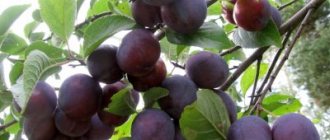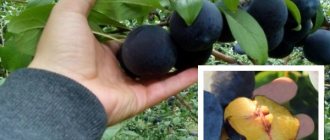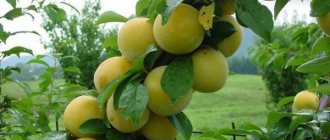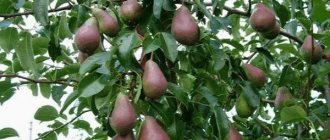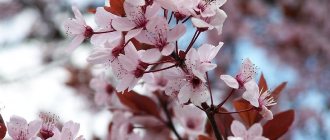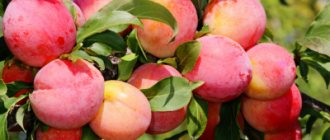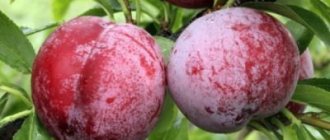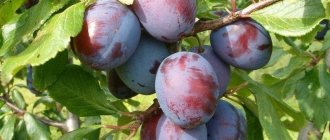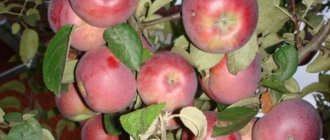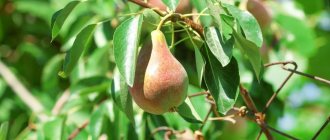Description and distinctive features of the Volga beauty plum
Volga Beauty is a hybrid variety bred in the first half of the twentieth century on the basis of Renclaude Beauvais and Skorospelka red. The author of the culture is the scientist E.P. Finaev. In 1965, plum was included in the State Register and recommended for use in the Lower Volga, Middle Volga and Central regions.
Volga beauty plum is a winter-hardy, productive variety of domestic selection.
Characteristic features of the variety:
- The tree is large in size with a rapid pace of development, reaching a height of 6–7 m.
- The plum has a raised, round, moderately thickened crown. The bark is smooth, gray in color. The shoots are straight, thick, bare. The main part of the harvest is formed on bouquet branches.
- The leaves are large, wide, ovoid, wrinkled, and light green in color. The surface of the plates is matte. There is slight pubescence on the leaves. There is serration along the edges. The petioles are thick. The inflorescences consist of double or triple white flowers.
- The fruits are large, their weight reaches 30–35 g. They have a round, slightly elongated shape. The upper part is slightly dented. There is a small depression at the base. The ventral suture is well defined. The stalks are thick and medium in size. Plums are purple with a red tint. The surface of the skin is covered with a waxy coating. It comes off the pulp without effort. You can also notice subcutaneous white dots on plums.
- The pulp is juicy, yellow-red, the juice is colorless. The fruits have a sweet and sour taste. The bone is small, oval, and comes off easily. The taste properties of plums are rated 4.5, appearance - 4.8 points on a five-point scale.
Important! A feature of the variety is drought and frost resistance.
Reviews from gardeners about the plum variety Volga Beauty
Gardeners' opinions about the Volga beauty plum are presented below.
- Tatyana Bulan : “Last year I first learned about the Volzhskaya Beauty variety and immediately purchased a seedling. I've heard a lot of good things about it, but my plum tree on the property is already old and needs replacing for a long time. So I decided to plant this variety. It satisfies all parameters, and most importantly – how tasty the plum fruits are, simply sugary, suitable for fresh food and for processing! But I don’t harvest much yet, so I just eat it fresh.”
- Evgeniy Chernyshov: “The Volga beauty plum was purchased along with the garden. This tree was already growing there, but it was small. After 5 years, we harvested our first big harvest and did not regret leaving it. It is easy to care for, grows quickly, produces a lot of harvest (but we have pollinating varieties on the site). My wife makes jam and compotes from the fruits, and covers the cream whole. They are delicious in any form! The only problem is that it needs to be treated for pests and diseases. We were late with processing in the spring, and a lot of the harvest was spoiled. And last year, with timely preventative treatment, the cream grew like a picture - without a single damage!”
- Sergey Pavlov : “When choosing a tree variety, I always look at the yield. The Volga beauty pleases not only with this quality, but also with the fact that it can grow on almost any land and does not require a lot of attention, like other hybrids. It grows well even under unfavorable conditions, the main thing is that there is enough sun, otherwise the ripening of the plum will be delayed.”
Advantages and disadvantages
This plum has many advantages that far outnumber the disadvantages.
Table: positive and negative properties of the variety
| Advantages | Flaws |
| Annual fruiting | Tendency of fruits to crack at high humidity |
| Early ripening (August 10–25) | |
| Early pregnancy (4–5 years) | Large tree size, making harvesting difficult |
| High yield (up to 25–30 kg per tree) | |
| Good frost resistance | Average transportability |
| High resistance to gray rot, gum disease, plum moth and cherry elephant moth | |
| Resistance to lack of moisture |
Tree
These are quite large plants, about seven meters high. For this reason, the Volga beauty plum (you can see the photo below) needs annual formative pruning, without which caring for the tree will be too complicated. The crown is formed using a low-tier or no-tier system. Pruning not only makes harvesting easier, but will also have a positive effect on fruit quality and yield.
The Volga beauty plum grows quite quickly, forming a spherical lush crown of medium density. The branches and shoots are covered with gray-brown bark.
Landing Features
The Volga beauty is capable of pollinating on its own, but the presence of pollinators helps increase fruiting. Varieties such as Zhiguli, Skorospelka red, Mirnaya, Ternosliva Kuibyshevskaya are suitable for this . This plum should be planted on flat areas or small slopes. The tree needs a lot of sunlight. And exposure to wind is undesirable for him.
To plant the Volga beauty, choose a sunny place on the plain.
The crop can be planted in the fall, in the third ten days of September, or in the spring, from April 20 to May 10. Gardeners consider the latter option more preferable. The plant is planted in warm soil, which promotes the development of the above-ground part. The tree also has time to take root and grow stronger before the onset of cold weather.
Important! The most suitable soil type will be light or medium loams, chernozems and marly clay with a neutral acid reaction.
Seedlings are selected according to the following characteristics;
- tree age - 1–2 years;
- height - 100–140 cm;
- trunk thickness - 1–1.5 cm;
- trunk height - 50–60 cm;
- the length of shoots in a two-year plant is 30 cm, in a one-year plant it is 15–20 cm;
- trunk diameter at a height of 10 cm from the graft - 1.5 cm;
- number of roots - 3–4;
- length of the root system - from 25 cm.
It is recommended to purchase plums for planting from specialized nurseries. To prevent the root system from drying out, it is wrapped in a damp cloth. It is not advisable to leave the plant without soil before planting. It’s better to bury the tree. To do this, prepare a hole up to 40–50 cm deep, where the seedling is placed in an inclined position. Then the root system and the base of the trunk are sprinkled with earth.
Plum planting is done in autumn or spring
The planting process is performed in the following order:
- For plums, dig a hole 50–60 cm deep and 100–110 cm wide.
- Then the resulting soil is mixed with 15 kg of compost, 300 g of superphosphate, 400 g of wood ash and 50 g of potassium chloride. A stake is installed in the center for support.
- Fill the hole 2/3 with the prepared mixture, after which the seedling is placed so that the root collar rises 5 cm above the surface.
- The tree should be located on the north side of the peg. The depression is covered with earth. The soil is lightly trampled.
- Then they retreat 40–50 cm from the trunk, dig a circular groove and water the plum with three buckets of water.
- The planting circle area is mulched with manure, sawdust or humus. The plant is tied to a support.
Important! Pollinators are planted 3 m from the Volga beauty, and when growing a large number of trees, a distance of 3–4 cm is left between the rows.
Video: practical tips for planting a tree
Reproduction methods
To extend the life of the plant or to be confident in the variety, it is better to get it on your site. The Volga beauty plum is easily propagated by gardeners on their own without going to nurseries. You can do this in several ways:
- Basal shoots. Usually it is removed, but if there is a need to breed the variety, this is one of the simplest ways.
- By cuttings. Prepare young shoots 20-30 cm long. They are germinated in winter and planted in open ground in spring. You can immediately plant them in a permanent place of growth.
- By layering. The lower branches are tilted to the ground and buried in soil. When they produce roots, they are completely separated from the mother tree.
Plant care
For normal growth and development of plums and ensuring high yields, an optimal amount of moisture in the soil is required. It is also necessary to feed the plant, loosen the soil and remove weeds.
Watering and loosening the soil
The soil around the tree must be kept loose. You should also remove weeds regularly. In the summer, the soil is loosened after watering to a depth of 7–10 cm. In the fall, digging is carried out to a level of 20 cm. This helps fight pests that go into the ground for the winter.
Watering is an important step in plum care
The tree is watered up to five times during the growing season and the last watering is performed in October. To do this, prepare a circular groove 10 cm deep. A hole is dug around the tree along the projection of the crown. After watering is completed, the tree trunk circle is covered with soil and covered with a 15 cm layer of mulch.
Table: norms and volumes of irrigation
| Period | Volume of water per tree |
| After the flowers form | 60–80 l |
| 2–3 weeks after the first watering | |
| Two weeks after the second watering | |
| At the stage of fruit formation | |
| After finishing the harvest | |
| Late September-early October | 150–250 l |
Fertilizer application
To form a good harvest, plums require nutrients.
Plum needs feeding to form tasty and large fruits.
Table: fertilizing schedule
| Application time | Nutrient elements | Norm per plant |
| Before the flowering stage begins | 25 g of ammonium nitrate when digging | For 1 m2 of tree trunk area |
| At the flowering stage | 20 g of urea per bucket of water | 5 l |
| After flowering is complete | 1 kg of manure per 10 liters of water, leave for 2 days | 2 l |
| In 2 weeks | ||
| Second half of June | 3 tbsp. l. superphosphate and nitrophoska, 2 tbsp. l. potassium sulfate per 10 liters of water | 20 l |
| End of September |
| 20 l |
Crown trimming
The first plum pruning is carried out after planting is completed. The scheme is as follows:
- For an annual seedling that does not have a crown, the above-ground part is removed to a level of 70 cm from the ground; if the plant has a crown, only the central shoot is shortened. It should rise 20 cm above the other branches.
- For a two-year-old tree, the side shoots are cut by a third, and the conductor is shortened in the same way as for a one-year-old plum. If there are two main shoots, one needs to be cut to the height of the side branches.
Pruning the crown will allow the strongest shoots to develop
Subsequently, the plum is pruned annually at the end of March and in October. Three rows of five branches are formed on the tree:
- The first of them should be placed at a height of 60 cm from the surface. At this level, select three well-developed branches with an angle of 50° from the trunk, growing in different directions. They should be placed every 25–30 cm.
- The second row is formed a year later at a distance of 60 cm from the first. Two shoots are left in it. They are selected according to the same characteristics as the branches of the first row.
- There will be only one branch in the third tier. It should be located 50 cm from the second tier. All other shoots are removed at the level of the ring influx.
- When all three rows are formed, thickening shoots are removed from the crown. The conductor is cut at a height of 20 cm from the remaining branches.
Autumn pruning is sanitary in nature . In October, they get rid of dry and broken shoots. When the growths decrease to 20 cm, anti-aging pruning begins. In this case, branches that are 3–4 years old are removed.
The next such procedure is carried out after 5 years. All damaged areas are treated with garden varnish. You can prepare the composition as follows. You need to mix 200 g of rosin and wax, 100 g of beef or lamb fat and melt the ingredients until smooth. Then the pitch is cooled and used to treat injured areas.
Video: how to trim a plum correctly
Preparing for winter
Volga beauty is positioned as a winter-hardy variety, but taking certain measures to prepare the tree for winter will allow it to endure this period more comfortably.
Whitewashing trees will protect them during winter
Gardeners do the following:
- After the leaves fall, the tree trunk circle is cleared of plant debris and dug up to a level of 20 cm.
- The stem and branches of fruiting plums are treated with whitewash, this helps prevent the appearance of pests. But first, dead areas of bark, mosses, lichens and various growths are removed from the tree.
- If living tissue was affected, the damaged areas are treated with varnish.
- After this, whitewash is applied with a paint brush in two layers. To prepare it, mix 8 liters of water, 1 kg of lime, 1 kg of chicken droppings or manure, 200 g of copper sulfate.
Important! For young trees that have not entered fruiting, whitewashing is replaced by covering with a piece of burlap or paper; film should not be used for this.
Video: useful tips for caring for plums
Planting and care
You can plant plums in spring and autumn ; specialists and experienced gardeners prefer to do this in spring. If seedlings are purchased in the fall, they can be buried for the winter.
To do this, make small holes up to half a meter deep, place the plant in the middle and cover it with earth.
ATTENTION! The seedlings are placed at an angle, the soil around them is slightly compacted so that a small depression remains, the layer of snow around the plant will be greater, this will protect it from frost.
The hole for planting must be prepared in advance; this can be done in the fall or spring, 10-12 days before planting the seedlings. They dig a hole a little more than half a meter deep and the same width, and mix the excavated soil with either rotted manure or compost as fertilizer. IMPORTANT. A stake is driven into the center of the hole; it is necessary to support the seedling for the first two years.
The plant is placed on the north side of the support and covered with prepared soil, while making sure that there should be soil between the roots of the plant. Before burying, shake the plant, and during backfilling, lightly compact the soil. When planting, the root collar should be several centimeters above ground level. The seedling is tied to a support, the plant is watered.
Caring for growing seedlings and mature trees is not very different from caring for other fruit crops.
IMPORTANT! Plum is a moisture-loving tree and needs to be watered, especially in dry summers, at least once a week.
Mineral fertilizers are applied in the third year after planting. The first two years of nutrients added during planting will be enough for the plant to grow successfully. Plum trees are fed three times a year. The first time before the flower opens, the second after the fruits form and the third time after they are harvested. Urea and potassium sulfate are used as fertilizers. The soil around the tree must be cleared of weeds, loosened, and fallen fruits and leaves removed.
For proper growth of the tree and its further successful fruiting, the tree is pruned, often done immediately after planting or the next year.
Proper pruning not only promotes successful growth, but also protects the tree from disease .
The trees are formed with a trunk of 25-40 cm, a crown of 7-8 correctly located branches. Some of the main branches are removed without leaving them next to each other, predicting the future shape of the tree.
Plums need to be prepared for the winter cold; they tolerate winter worse than apple and pear trees . First you need to fertilize, after digging the soil around the tree. If the plant bears fruit, whitewash the trunk. Check if there are damaged areas on the tree, remove moss, and if necessary, coat some parts with garden varnish.
NOTE! If the autumn was dry, water the plant generously before the first frost. The seedlings can be bent to the ground and covered with spruce branches, spruce branches or sawdust; the trunks can be tied with roofing felt or any old material.
Diseases and pests
The Volga beauty is relatively resistant to fungal diseases, but there are some ailments, such as fruit rot, root canker, and coccomycosis, that pose a danger to this plum.
Table: cultural diseases
| Diseases | Signs of defeat | Treatment options | Preventive measures |
| Fruit rot | Brown spots form on the plums, the surface of which is covered with grayish-brown swellings. | Use of Bordeaux mixture 1% concentration. | Removing damaged fruits and then burying them in the soil to a depth of 50 cm. |
| Pockets (marsupial disease) |
| Spraying with 0.2% copper oxychloride (20 g of substance per 10 liters of water). | Cleaning and composting damaged drains. |
| Coccomycosis |
| Treatment after collecting plums with 1% Bordeaux mixture. | Burning fallen leaves that may contain the causative agent of coccomycosis. |
| Sooty fungus | The branches and leaves are covered with a black coating, which is easily erased, but its presence makes it difficult for light and air to penetrate the plant. | Spraying with a composition of 5 g of copper sulfate, 150 g of laundry soap and 10 liters of water. | Compliance with recommended norms when watering. |
| Root cancer |
| The disease cannot be treated. |
|
Photo gallery: diseases typical for the variety
Fruit rot can ruin an entire crop
Coccomycosis inhibits tree foliage
Root cancer leads to the death of plums
Sooty fungus weakens the crop, impairing yield
Marsupial disease deprives plum crops
Table: pests affecting plums
| Pests | Signs | Fighting methods | Prevention |
| Plum sawfly | Insects lay eggs in buds and flowers, the larvae damage the pulp of the ovaries, causing them to fall off. | Treatment 5–7 days after flowering with Aktara (1.4 g per 10 l) or Confidor (2.5 ml per 10 l). | Autumn digging of the trunk area and row spacing. |
| Centipede |
| ||
| False shield | The larvae suck the juice out of the plant, which leads to the falling of leaves and drying out of the shoots. |
| Removing dead parts of the bark under which the pest can overwinter. |
| Comma scale insect | The pest feeds on the sap of the bark, the damaged areas die and fall off. | ||
| Aphid | The larvae are located on leaves, which curl up as a result of exposure to the pest. | Spraying in early spring before buds open with Nitrophen solution or before flowering with Karbofos (20 g per 10 l). |
|
Photo gallery: parasites characteristic of the crop
The comma scale insect is a common pest of fruit crops.
False scale insects damage plum shoots and leaves
Plum sawfly damages fruits
Aphids quickly eat the shoots and leaves of the tree. The centipede causes plums to fall off.
Pests and their control
Plum moth. The caterpillar devours the fruit and it dries. There is only one method of control: manual collection of parasites, collection and destruction of damaged fruits and leaves.
Plum aphid. The parasite destroys the leaves of the plant. Spraying with Bordeaux mixture helps; do the procedure several times a season. Solutions of onions, garlic, dandelion and laundry soap help.
Rose leaflet. The leaf of the plant is affected, deformed and dries out. Spraying with Bordeaux mixture helps.
ATTENTION! Treat before flowering.
Plum sawyer. Loves the fruits of the plant. Spraying is done in the spring, pests are collected and destroyed.
Plum silkworm. The caterpillar feeds on leaves and fruits. Insects are simply cleaned from the tree and sprayed in the spring before flowering begins.
Rodents. In winter, rodents eat the trunks and roots of plants in search of food. For the winter, trees are tied with paper, straw, roofing felt, covered or tied with spruce branches.
Features of harvesting and storage
Fruiting of the Volga beauty begins in the fourth or fifth year after planting. Fruit harvesting takes place from the second decade until the end of August. Yield indicators depend on the age of the plant. The productivity of an eight-year-old plant is 8–10 kg, and a tree from 9 to 12 years old bears 15–30 kg of fruit. During the collection process, it is necessary to preserve as much wax as possible on the plums.
Volga beauty is widely used for making desserts and drinks
Plums are placed in wooden or plastic boxes in 3-4 layers. The bottom of the container is covered with paper. Store the crop at 4–5 °C and humidity 85–90% for two weeks. Volzhskaya Krasavitsa variety plums are used to make preserves, syrups, jams, confitures, and drinks.
For longer storage they are frozen. The fruits are thoroughly washed, dried, placed on a wooden tray and refrigerated for several hours. Then they are distributed into plastic bags and placed in the freezer.
Planting a seedling
Drive a peg into the center of the prepared hole to tie the tree. Around it, form a small mound of nutritious soil, which you also prepared in advance. Place the seedling in the hole so that the peg is on the south side and straighten the roots well. It is necessary to correctly determine the depth so that after planting and subsequent watering the root collar is raised above the soil surface by five centimeters.
Form an earthen roller with a radius of no more than half a meter around the young tree. Water the plant generously (at least three buckets of water). Mulch the tree trunk using rotted sawdust, mowed grass, and peat.
Features of the plum variety
The plum in question has features that include many positive qualities that outweigh its disadvantages.
Advantages
- Among the positive features of culture are the following:
- fruiting every season;
- self-pollinating;
- early fruit ripening (early August);
- the first harvest of fruits is quite early (from 4 years);
- high yield (one tree can produce over 25 kg);
- frost resistance;
- the variety is not affected by gray rot, gum disease, plum moth, or cherry elephant;
- tolerates lack of moisture well.
Flaws
- The plum variety described has minor disadvantages:
- high air humidity contributes to fruit cracking;
- harvesting becomes difficult due to the large size of the trees;
- fruits with average shelf life and transportability.
Landing
In order to get a rich harvest of fruits in the future, you need to choose the right place for planting, prepare the soil and purchase planting material. The favorable time for planting plums is early spring or early autumn.
When planting in autumn, it is better to use seedlings with a closed root system.
Choosing a seedling
When purchasing a seedling, you should choose zoned, two-year-old trees - they take root well. The root length must be at least 10 cm. A healthy seedling has no dry branches or roots. The trunk bark is clean, smooth, without wrinkled areas, spots or any damage.
Plum seedlings must have a central branch and at least three lateral skeletal branches
It is best to purchase seedlings in garden stores and special nurseries, and not in the market.
Choosing a place and preparing the land
Plums should be planted in a well-lit, elevated area. The soil should be loose, with an acidity of 6–7 pH. Light loamy soil or marly clay is suitable.
Low-lying areas with stagnant water should be avoided. The groundwater level is at least 2 m.
You first need to prepare the planting hole. Autumn preparation of the hole before spring planting: dig a hole about 50 cm deep and 70–80 cm in diameter. The soil is mixed with 3–4 buckets of fresh manure and 250 g of phosphorus-potassium fertilizers.
In spring, the pit is prepared 14 days before planting the planting material. The excavated soil is mixed with 4 buckets of rotted compost, 100 g of potash and 100 g of phosphate fertilizers.
To reduce the acidity of the soil, fill the hole with an alkaline solution of quicklime - 200 g of powder per 10 liters of water.
Step-by-step description of the process
Before planting, remove all damaged branches and roots from the seedling, and tear off the blossoming leaves.
- In the prepared area, dig a hole about 45 cm deep and 60 cm in diameter.
- Soil is poured into the bottom of the hole in the form of a mound and a wooden stake is driven in.
- A seedling is placed in the hole and the roots are straightened. The root collar of the tree should be 5–8 cm higher than the level of the hole.
- The seedling is covered with earth and compacted carefully.
- The tree is tied to a peg with twine.
- A hole with a diameter of about 50 cm is formed.
- Water the seedling with 3 buckets of water.
- When the moisture is absorbed, the hole is mulched with fresh soil or sawdust.
Planting pattern: 4.0–4.5 x 2.0–3.0 m.
Video: planting and fertilizing plums
Organization of care
By following all the rules of agricultural technology, you can grow a healthy crop from a seedling and harvest it annually.
Watering
The plum tree is watered regularly, at least 5 times a year in spring and summer. One tree requires up to 15 liters of water.
The crop is watered before flowering begins, 14 days after flowering ends.
After that, the soil is moistened after 20 days and when fruits are formed, they ripen. Additionally, the tree is watered in the fall to increase winter hardiness. One plum requires 20-25 liters of water.
See also
Description of the Tsarskaya cherry plum variety, planting and care rules
Read
From the age of 5, the plum is watered less frequently - once every 30 days.
Features of fertilizing
Fertilizers are applied in the 3rd year of seedling growth. Urea and potassium sulfate are used. From organic products, use a solution of ash, mullein - 2 buckets of fertilizer per barrel of water. The mass is infused for a day until the substances dissolve, after which root feeding is done.
In the summer season, the following organic fertilizers are used:
- nitrophoska;
- superphosphate;
- potassium sulfate.
In the fall, the tree is fed with superphosphate and potassium chloride. Dry superphosphate is sprinkled on the ground while loosening around the trunk. To prepare the working solution, you need 2 tbsp. l. dilute fertilizers in 20 liters of water.
The last fertilizer is applied in October.
Crown trimming
The crown is formed from the 2nd year after planting. Pruning is carried out in early spring, until the process of sap movement begins.
In the 2nd year after planting, the main trunk is shortened by 1 meter. Afterwards, the traditional procedure is applied - the tiered method:
- The lower level has 3 branches, located 60 cm from the soil.
- At the 2nd level there should be 2 branches, 50-60 cm higher than the lower ones.
- The third tier is 50 cm higher than the 2nd and has 1 branch. The next spring, after the main pruning, the shoot above this branch is cut into a ring.
Subsequent pruning of the plum is carried out with pruning of grown shoots, excluding thickening branches.
In addition to the main pruning, a sanitary procedure is carried out. As a rule, it is carried out in the fall, excluding shoots that are affected and have symptoms of the disease.
For an adult plum tree, rejuvenating pruning is used. The procedure takes place in the spring; branches with internal growth that intersect or thicken the crown are removed.
Loosening and mulching the tree trunk circle
The soil around the plum must be kept loose. A weed removal procedure is required.
In summer, the soil is loosened to a depth of 10 cm after watering. In autumn, digging is carried out up to 20 cm deep. This allows you to fight harmful insects that overwinter in the soil.
Seasonal treatments
The plum variety is considered a universal crop that is resistant to pathologies and pests. In this case, an important process is seasonal processing of wood, which will eliminate serious problems.
When to carry out the procedure, the gardener himself chooses:
- Spring - spray the garden using diesel fuel to destroy the larvae that sleep under the bark.
- Summer - emergency treatment of plums, carried out when the plant is sick and has been attacked by insects.
- Autumn - the garden is prepared for winter, visually inspected, and sprayed against pests.
Protecting plums from rodents
In winter, rodents eat the bark and roots of plum trees. To protect the tree, it needs to be wrapped in paper, roofing felt, or cloth soaked in creolin.
Shelter for the winter
Before the onset of cold weather, the trunk and main branches are whitened, the soil near the trunk is loosened, and the soil is mulched using peat and compost.
Then the young plum tree bends towards the soil and is covered with spruce branches, hay, and bamboo. When snow falls, it forms a warm blanket; the tree underneath does not freeze.
To protect from strong winds, they make a pyramid of slats and wrap the tree with non-woven material.
History of selection and description of the variety
The type of domestic plum (domestica prunus) Volga beauty was bred in 1939 at the zonal horticultural station “Zhiguli Gardens” (Samara). At the same time, the varieties Renclaude Beauvais and Skorospelka red were crossed. The authorship belongs to the breeder E. Finaev.
Did you know? There are no varieties of wild plums in nature, only cultivated ones, since the garden plum, the ancestor of all table varieties, is a product of selection. It was bred about 2 thousand years ago by crossing wild crops - blackthorn and cherry plum.
Later, in the mid-1950s, a new type of plum was sent for state testing, and after 10 years it was included in the state register of breeding achievements of the Russian Federation.
The characteristic features of these fruit trees are:
- the culture is developing rapidly and is large in size, growing up to 7 m;
- rounded crown with straight, thickened, bare shoots raised upward and moderately thickened;
- the trunk bark is smooth, gray in color;
- wide, ovate, large leaves of a pale green color, with a matte surface and slight pubescence; the edges of the leaves are jagged;
- inflorescences of two or three white flowers;
- round and somewhat elongated, large plums, each weighing up to 35 g;
- plums are purple, with a reddish tint, whitish specks are visible under the skin; the skin is easily removed and has a waxy coating; inside the fruits are juicy, with yellow-red pulp, taste sweet and sour; with small, easily separated oval bones.
Important! Although the Volga beauty is a self-pollinating species, it is permissible to plant pollinating varieties in the area with its plantings - this will help increase the crop yield.

